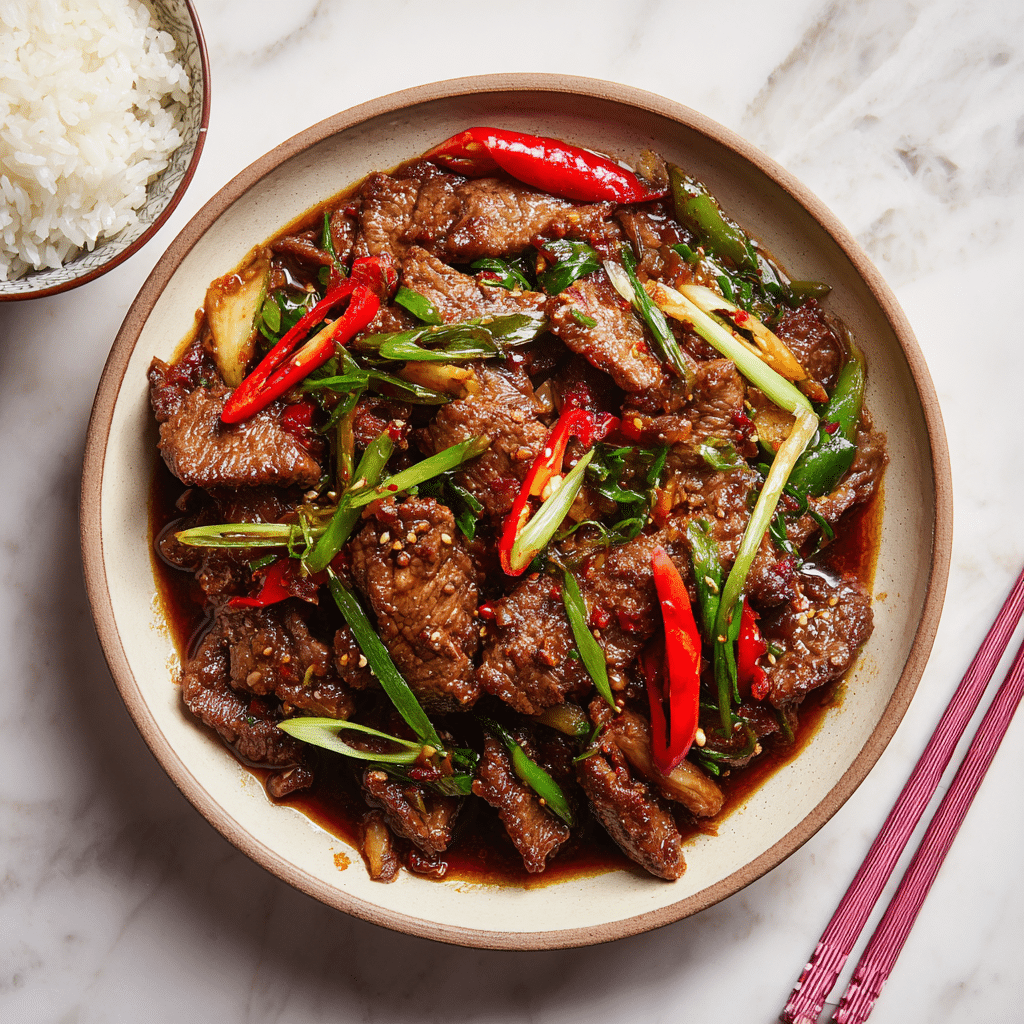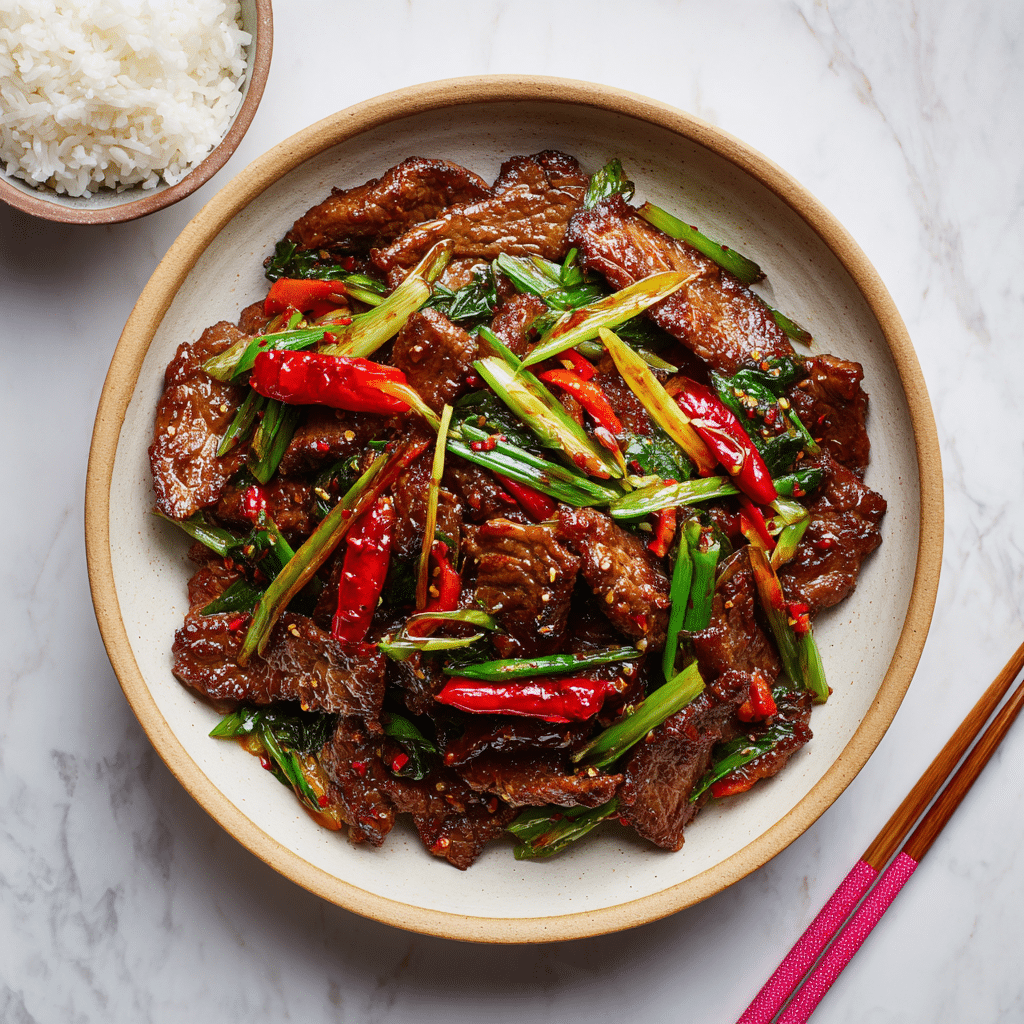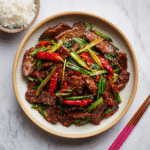Juicy strips of beef caramelized in a sweet-and-savory garlic soy glaze—that’s the magic of Mongolian Beef. This popular Chinese-American dish is famous for its glossy sauce, tender texture, and bold flavor punch. Best of all? It’s a 30-minute recipe you can make at home with pantry staples. Sticky, saucy, and perfectly satisfying, Mongolian Beef is a go-to dinner you’ll want on repeat.
Origins of Mongolian Beef – Chinese-American Comfort
Despite the name, Mongolian Beef doesn’t originate from Mongolia. It’s a classic dish in American Chinese restaurants, with roots in Taiwan’s Mongolian barbecue-style cooking, which itself is a misnomer. The dish became famous for its tender beef and glossy sauce—often paired with white rice or lo mein.
While traditional Chinese flavors often lean savory and umami-rich, Mongolian Beef leans sweet and garlicky, making it especially appealing to Western palates. The caramelized edges of beef and that silky sauce make this a comforting, fast favorite in home kitchens across the world.
Ingredient Breakdown – The Secret Behind the Sauce

Each element of Mongolian Beef brings depth and balance to the dish. Here’s what makes it work:
Flank Steak (1 lb, thinly sliced)
Flank steak is the classic choice for Mongolian Beef. It’s lean but flavorful, and when sliced against the grain and cooked quickly, it stays tender and juicy.
Cornstarch (¼ cup)
Tossing the beef in cornstarch gives it a light coating that crisps up in the pan and helps thicken the sauce as it cooks. This technique is called “velveting” in Chinese cooking.
Soy Sauce (½ cup, low sodium)
The base of the sauce—brings saltiness, umami, and a rich fermented depth.
Brown Sugar (⅓ cup)
Adds sweetness and helps the sauce caramelize beautifully in the pan. Dark brown sugar adds even more molasses flavor.
Garlic (4 cloves, minced)
Garlic is a must—its sharp, aromatic kick defines the dish.
Fresh Ginger (1 tbsp, grated)
Ginger adds a warm zing and balances the sweetness with freshness.
Water (½ cup)
Dilutes the sauce slightly so it can reduce and thicken in the pan.
Oil (for searing)
High-heat oil like vegetable, peanut, or avocado oil helps the beef sear fast without burning.
Green Onions (3 stalks, chopped)
Adds a mild onion flavor and a pop of freshness at the end. Use both white and green parts.
Optional: Red Pepper Flakes or Thai Chili (for heat)
If you like spice, a small amount goes a long way to add a kick.
Step-by-Step: How to Make Mongolian Beef
You’ll be surprised at how fast and easy this dish comes together.
Step 1: Prep the Beef
-
Slice flank steak thinly against the grain into ¼-inch strips.
-
Toss the beef with cornstarch in a bowl until coated evenly.
-
Let it rest for 10 minutes while you make the sauce and heat the pan.
Step 2: Make the Sauce
In a small bowl, whisk together:
-
Soy sauce
-
Brown sugar
-
Water
-
Garlic
-
Ginger
-
(Optional) Red pepper flakes
Set aside. The sugar will dissolve and begin blending with the aromatics.
Step 3: Sear the Beef
-
Heat 2–3 tablespoons of oil in a large skillet or wok over high heat.
-
Working in batches, sear the beef for 1–2 minutes per side until browned and crispy at the edges.
-
Remove beef and set aside.
Step 4: Simmer the Sauce
-
In the same skillet, pour in the sauce mixture.
-
Bring to a simmer, scraping up browned bits from the pan.
-
Let it reduce for 2–3 minutes until slightly thickened.
Step 5: Finish and Combine
-
Return the beef to the skillet.
-
Toss to coat in sauce and simmer 1–2 minutes more until the sauce clings to the meat.
-
Stir in chopped green onions.
Variations, Substitutions, and Tips
Mongolian Beef is extremely adaptable. Here’s how to make it your own or fit special diets:
Variations
-
Spicy Mongolian Beef: Add sliced Thai chilies or 1 tsp sriracha to the sauce.
-
Veggie Boost: Add broccoli, bell peppers, or snow peas.
-
Noodle Version: Toss the beef and sauce with cooked lo mein or rice noodles.
Substitutions
-
Beef Cuts: Use skirt steak, sirloin, or flat iron if flank isn’t available.
-
Sugar: Substitute honey or coconut sugar for a refined-sugar-free option.
-
Gluten-Free: Use tamari instead of soy sauce, and ensure cornstarch is certified GF.
Cooking Tips
-
Thin slices = tender beef: Freeze the steak for 20 minutes before slicing for easier cutting.
-
Work in batches: Overcrowding the pan will steam the beef instead of searing.
-
Don’t overcook: Beef should be cooked fast and hot to stay tender.
How to Serve Mongolian Beef
The glossy, umami-packed sauce of Mongolian Beef demands something to soak it up. Here’s how to serve it like a pro:
Best Side Pairings:
-
Steamed white rice: Classic and simple.
-
Jasmine or basmati rice: Adds aroma and elegance.
-
Fried rice: For a takeout-style feast.
-
Lo mein or rice noodles: A slurp-worthy upgrade.
-
Stir-fried vegetables: Broccoli, bok choy, or baby corn balance the richness.
Occasions:
-
Weeknight dinners: Fast enough for a Tuesday.
-
Meal prep: Stores well and reheats beautifully.
-
Dinner parties: Serve family-style with spring rolls or dumplings.
Nutrition and Health Notes
Mongolian Beef is indulgent but can be tweaked to align with your health goals:
-
Protein-packed: Great for building muscle and keeping you full.
-
Customizable sweetness: Adjust the sugar based on your preference.
-
Low-carb option: Serve with cauliflower rice or over steamed veggies.
-
Balanced fat: Use lean steak and limit oil for a lighter dish.
With smart swaps and portion awareness, you can enjoy it regularly without the takeout guilt.
FAQ – Mongolian Beef
1. Can I make Mongolian Beef ahead of time?
Yes. Cook the beef and sauce, then store separately or combined in the fridge for up to 4 days. Reheat gently on the stove or microwave.
2. What beef cut is best?
Flank steak is traditional, but skirt steak, sirloin, or flat iron are great substitutes when sliced thinly against the grain.
3. Can I freeze it?
Yes. Freeze cooled Mongolian Beef in an airtight container for up to 2 months. Thaw overnight in the fridge before reheating.
4. Is Mongolian Beef spicy?
Not inherently. It’s typically mild and sweet, but you can add chili flakes or hot sauce for heat.
5. Can I make it vegetarian?
Yes. Swap the beef for tofu, tempeh, or mushrooms. Use the same sauce and cooking technique.
6. Why is my beef tough?
It may be overcooked or sliced with the grain. Always cut against the grain and cook briefly over high heat.
7. What’s the secret to restaurant-style sauce?
High heat, cornstarch coating on the beef, and reducing the sauce just enough to get that glossy, sticky consistency.
Mongolian Beef – Quick, Saucy, and Better Than Takeout
5 Stars 4 Stars 3 Stars 2 Stars 1 Star
No reviews
Mongolian Beef is a fast, flavorful stir-fry made with tender slices of seared beef coated in a garlicky, sweet soy sauce. Better than takeout and done in 30 minutes.
- Author: Maya Lawson
- Prep Time: 10 minutes
- Cook Time: 20 minutes
- Total Time: 30 minutes
- Yield: 4 servings 1x
Ingredients
-
1 lb flank steak, sliced thin against the grain
-
¼ cup cornstarch
-
2–3 tbsp oil (for frying)
-
½ cup low sodium soy sauce
-
⅓ cup brown sugar
-
½ cup water
-
4 cloves garlic, minced
-
1 tbsp fresh ginger, grated
-
3 green onions, chopped
-
Optional: red pepper flakes or Thai chili for heat
Instructions
-
Toss beef in cornstarch. Let rest 10 minutes.
-
In a small bowl, whisk soy sauce, brown sugar, water, garlic, and ginger.
-
Heat oil in skillet over high heat. Sear beef in batches until browned. Remove and set aside.
-
Pour sauce into skillet. Simmer 2–3 minutes until slightly thick.
-
Return beef and toss to coat. Cook 1–2 more minutes.
-
Stir in green onions. Serve hot with rice or noodles.

